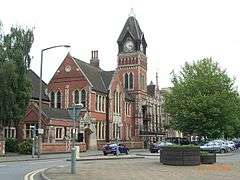Burton upon Trent Town Hall
Burton upon Trent Town Hall is a municipal building in King Edward Place, Burton upon Trent, Staffordshire, England. It is a Grade II listed building.[1]
| Burton upon Trent Town Hall | |
|---|---|
 Burton upon Trent Town Hall | |
| Location | King Edward Place, Burton upon Trent |
| Coordinates | 52.8080°N 1.6454°W |
| Built | 1878 |
| Architect | Reginald Churchill |
| Architectural style(s) | Victorian Gothic style |
Listed Building – Grade II | |
| Designated | 22 June 1979 |
| Reference no. | 1038703 |
 Shown in Staffordshire | |
History
.jpg)
In the mid 19th century local council meetings were held in the old Town Hall in the Market Square:[2] this was a building which had been designed in the classical style, possibly by James Wyatt, and completed in 1772.[3][lower-alpha 1]
The current building, which was designed by Reginald Churchill in a Victorian Gothic style, was commissioned by Michael Thomas Bass for use as the St Paul's Institute and the Liberal Club and completed in 1878.[1] Bass' son, Michael Arthur Bass, donated the building to the town in 1891[3] and it was extended, by the inclusion of purpose-built municipal offices, a council chamber, a concert hall and a new staircase, in 1894.[4] A statue by F. W. Pomeroy of Michael Arthur Bass (by then Lord Burton) was erected in the square in front of the building in 1911.[5] A further large extension, designed by George Moncur, the borough surveyor, in the Art Deco style was built to the southeast of the main building and completed in 1939.[3]
The new town hall initially became the headquarters of Burton upon Trent municipal borough, before becoming the headquarters of Burton upon Trent County Borough in 1901 and, more recently, of East Staffordshire Borough Council in 1974.[6]
Queen Elizabeth II, accompanied by the Duke of Edinburgh, visited the town hall and waved to the crowd from the town hall balcony on 28 March 1957.[7]
The hall boasts a Wurlitzer organ, which had originally been installed at the Cameo Theatre in Cleveland, Ohio in 1925; after a fire in the theatre it was repossessed by its manufacturer before being installed at the Forum Cinema in Wythenshawe in 1934 and then being moved Burton upon Trent Town Hall in 1973.[8][9] In 1995 OS Digital Recordings released a recording from Burton upon Trent Town Hall entled "Come Dancing" which involved excerpts of music performed by Arnold Loxam on the organ.[10]
In the entrance lobby are four large wooden plaques, listing the names of the men of the County Borough of Burton who gave their lives in each world war.[11]
Notes
- The old Town Hall was demolished in 1884.[2]
References
- Historic England. "Town Hall, Burton upon Trent (1038703)". National Heritage List for England. Retrieved 9 July 2020.
- "Old Town Hall, Burton upon Trent". Staffordshire Past Track. Retrieved 9 July 2020.
- Tringham, Nigel J (2003). "'Burton-upon-Trent: Local government', in A History of the County of Stafford: Volume 9, Burton-Upon-Trent". London: British History Online. pp. 85–97. Retrieved 9 July 2020.
- "Council Chamber, Town Hall, Burton-upon-Trent". Staffordshire Past Track. Retrieved 9 July 2020.
- Historic England. "Statue of Michael Arthur Bass (Grade II) (1038704)". National Heritage List for England. Retrieved 9 July 2020.
- "Contact us". East Staffordshire Borough Council website. East Staffordshire Borough Council. Archived from the original on 22 March 2012. Retrieved 29 March 2012.
- "A look back at the visits by the Queen to the Burton and East Staffordshire area". Staffordshire Live. 28 June 2017. Retrieved 9 July 2020.
- "Burton, Town Hall". The Cinema Organ Society. Retrieved 9 July 2020.
- "Burton Town Hall". My Ballroom. Retrieved 9 July 2020.
- "Come Dancing with Arnold Loxam". Organs.uk. Retrieved 9 July 2020.
- "Burton Town Hall War Memorial Plaques". Warmemorialsonline.org.uk. Retrieved 9 July 2020.